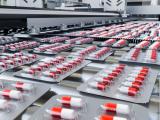Amid shortages going back months to over a year of dextrose syringes and intravenous fluid bags to treat a wide variety of emergency conditions, US emergency medical services (EMS) are scrambling to adapt treatment protocols and conduct trainings on how to use them.
Dextrose is a critical drug used to treat conditions such as low blood sugar (hypoglycemia), dehydration, acute alcohol poisoning, and high potassium levels, or as a carbohydrate in parenteral nutrition, according to David Margraf, PharmD, PhD, pharmaceutical research scientist at the Resilient Drug Supply Project (RDSP), part of the University of Minnesota's Center for Infectious Disease Research and Policy (CIDRAP), publisher of CIDRAP News
While oral glucose could be substituted for dextrose injections, Margraf said, "There will be many patients who can't take anything by mouth, so they need intravenous or intraosseous dextrose. The other option is intramuscular or intranasal glucagon, but this drug is expensive, in shortage, and may not be the appropriate treatment for some patients."
Glucagon also has the disadvantages of having a slower onset of action and being more difficult to administer than dextrose. "Prefilled dextrose syringes are preferred, but many times EMS use dextrose from large bags," Margraf said. "This adds time and complexity."
And because supplies of glucagon, a hormone that stimulates the production and release of glucose, haven't shipped for more than 6 months and are on backorder, many EMS agencies no longer even include it in their treatment protocols, according to EMS1.
Some products backordered until 2023
Per the US Food and Drug Administration (FDA), dextrose formulations in shortage include dextrose 25% injection (manufacturer Hospira/Pfizer, reported on February 2022) and dextrose 50% injection (Amphastar Pharmaceuticals and Hospira, January 2022). The American Society of Health-System Pharmacists (ASHP) reports the same shortages, with the addition of dextrose large-volume 70% injection (B. Braun Medical and ICU Medical, July 2022).
While B. Braun, Baxter Healthcare, Fresenius Kabi, and ICU Medical report backorders or very limited quantities of dextrose 5% injection and small-volume dextrose 10% injection (for which there was a historically low demand), and Pfizer reports limited quantities of dextrose 25%, supply is expected to far outstrip demand into the fall. Reasons cited by the manufacturers are either "demand increase for the drug" or "other."
In a Mar 4, 2022, letter to emergency-syringe customers, for example, Pfizer attributed product shortages to "a complex combination of factors, including significant and sustained increases in demand for products across our portfolio, largely due to competitor shortages as well as other COVID-19 related impacts and isolated manufacturing delays, many of which have now been resolved. While Pfizer has worked to meet this increased demand, which is well above historical volumes, the market need continues to outpace Pfizer's production capacity."
In the letter, Pfizer had estimated that its dextrose 25% formulation would be back in stock in June 2022 (although as of Aug 4, 2022, it remains in shortage) but that the 50% product is not expected until January 2023.
While the FDA knows of the dextrose and glucagon shortages, EMS1 reports that the likelihood of manufacturing capacity to produce these products anytime soon is very low. "And if the products are being manufactured in a site prone to tropical weather, there is always the potential that shortage could worsen further, as occurred in 2017," the article stated.
Downstream impact, increased costs
Stephen Schondelmeyer, PharmD, PhD, co-principal investigator for RDSP, said that dextrose is a cornerstone among EMS supplies.
"The recent shortages of dextrose are having a far-reaching impact on virtually all firefighters, paramedics, and EMS technicians nationwide," he said. "Emergency kits must be adapted to include different forms of dextrose or alternative products that are currently available. This change is no small task, since treatment protocols must be revised and updated, and new training may be needed."
New sources for these alternative products need to be identified and inventory levels established and maintained, according to Schondelmeyer. "Collaboration among healthcare systems and regional distributors is needed to efficiently acquire alternative supplies," he said. "All of these adjustments are triggered by the shortage of dextrose and add more costs and complexity to emergency medical systems."
"The shortage of dextrose solutions provides yet another illustration of the profound cascading impact from failures in the market and the downstream supply chain for essential medications," Schondelmeyer added.























